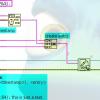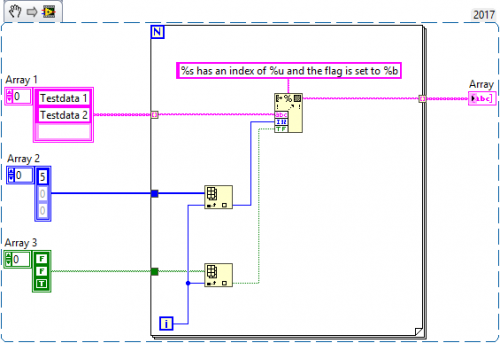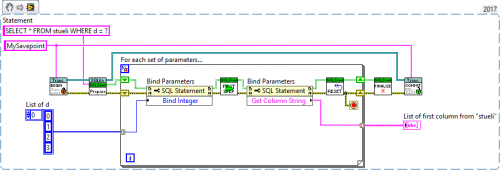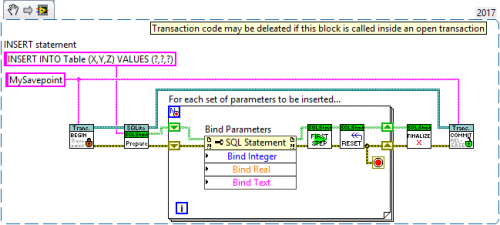-
Posts
720 -
Joined
-
Last visited
-
Days Won
81
Content Type
Profiles
Forums
Downloads
Gallery
Everything posted by LogMAN
-

How can I improve while loop speed on windows?
LogMAN replied to LAVA Good's topic in LabVIEW General
There are multiple ways actually. Here are a few that come to mind: Let it run faster by adjusting the code inside the loop accordingly Split it into multiple loops to utilize more cores of your CPU Buy a faster computer Note that there is a limit to how many concurrent threads LV supports: https://knowledge.ni.com/KnowledgeArticleDetails?id=kA00Z000000PARmSAO&l=en-US The maximum speed of a while loop is only limited by the speed of your CPU at 100% load (and of course the way your operating system shares the CPU between processes and threads). That is assuming your loop does nothing, which makes it pretty useless. Of course, if your computer has multiple cores, you can run multiple loops in parallel to make use of them. This is contradictory to your first statement. I suppose you mean to increase the loop speed, right? If your code is simple, it should be easy to optimize for speed or to run multiple instances concurrently if applicable. -

Lost UDP packets due to ARP
LogMAN replied to Michael Aivaliotis's topic in Remote Control, Monitoring and the Internet
I think this is a valid comparison: (from https://forums.ni.com/t5/LabVIEW/Global-Variables-Are-Better-than-Functional-Globals-So-There/td-p/1528392/page/5) You are either Novice or Guru 😋 -

Lost UDP packets due to ARP
LogMAN replied to Michael Aivaliotis's topic in Remote Control, Monitoring and the Internet
Here are some links to MS Docs that might be helpful: Using the Address Resolution Protocol Description of Address Resolution Protocol (ARP) caching behavior in Windows Vista TCP/IP implementations The second one is for Vista. I couldn't come up with any information on W10, so details can/will differ. Not sure if I misinterpret the information, but shouldn't the ARP table keep updating (i.e. not sending additional ARP requests) while packages are being transfered, or is this limited to TCP? If an entry is not used for a time between 15 to 45 seconds, it changes to the "Stale" state. Then, the host must send an ARP Request for IPV4 to the network when any IP datagram is sent to that destination. RFC 826 only mentions timeouts briefly: It may be desirable to have table aging and/or timeouts. The implementation of these is outside the scope of this protocol. -
I just had this issue and found a way to reproduce (and fix) it: Create a new VI in a library (use the right click menu of the library to create the VI). Place the VI on the block diagram of another VI The VI is only selectable if the selection goes completely around it. To fix it, open the icon editor on the offending VI and simply press OK to close it. Now selection works as expected (i.e. partial selection selects the VI).
-

Style Tips for Spaghetti Block Diagram
LogMAN replied to TUzzell's topic in Application Design & Architecture
Good point. Now that you mention it, the output of the multiplication functions are connected to a VI that (as far as I can tell) builds status messages and updates the progress bar (see the references connected to it). The output of that VI is displayed on the FP at a rapid pace. The VI obviously has too many responsibilities and should be split into multiple VIs. For example: Calculate Progress Calculate Estimate Time To Complete Calculate Estimate Time To Next User Action Display Progress Display Status Message Display Time To Complete Display Time To Next User Action These VIs can be put in sequence, which makes it very easy to follow. It's also much more reusable than the current solution. I'm well aware that the example above is probably too fine grained for the purpose of this application, but there is a high chance that each of these VIs can be reused multiple times or even omitted if not needed. That is not possible with the current solution. That is probably why there are two Boolean constants attached to the VI right now (i.e. too enable features that are only required in this particular section of code). -
If the boolean controls are clicked by the user, use the event structure instead: http://www.ni.com/white-paper/3331/en/
-

Style Tips for Spaghetti Block Diagram
LogMAN replied to TUzzell's topic in Application Design & Architecture
@smithd has stated very important points. It's also very important to get accustomed to techniques like the state machine in order to keep the code readable. However, in my experience it is very unlikely that a) shifting to a new system (like Teststand) solves the problem. That's for the same reason the previous one failed: A lack of understanding, planning and structure. b) using "better" techniques improve the application. Again for the same reason. c) replacing the current structure is even remotely possible because either the lead programmer left (or rather ran away) or it is too complex to comprehend. Edit: To clarify, you should take those solutions into consideration of course! This is of course my personal experience. Your situation may be entirely different. That being said, I'm sure we all have made these mistakes and learned from it. You should do the same. At first glance your VI looks confusing and hardly maintainable. On a closer look, however, it strikes me as a rather simple VI (i.e. not many different jobs going on at the same time) that only lacks structure and uses way too many indicators that presumably serve no real purpose other than being there (and maybe occasionally being viewed). I think the word we agreed on for such a VI is "paintainable", right? You asked for suggestions to improving your current situation, so find below a summary of what you can do, based on the code you shared: Remove code that is only meant for debugging purposes. With this I mean indicators such as the ones in the inner while loop. If the loop runs at max. speed, it updates the indicators every 20 ms. That is quite a bit faster than any human being can physically comprehend. Therefore, you have no reason to keep the indicators updating inside the loop. If you need to display the last value, simply move them outside the loop and use the last value. Once you removed the indicators, remove any code that isn't connected anymore. That should get rid of "dead" code. Take a closer look at the inner while loop and replace it by a for loop If you look closely, you'll notice that the inner while loop is actually a for loop. The conditions are: a) The boolean control "Stop Loops and Save Data 2" must be True, or b) The number of iterations is equal to the length of the "Frequency" array. Condition b) is clearly a perfect fit for for loops. Once you have made it a for loop, the second condition can simply be removed, which makes it a bit easier to understand. Move static functions outside the loop Inside the inner while loop are some multiplication functions that multiply values that come from outside the loop. These functions will always produce the same result inside the loop and therefore should be placed outside. It's a small change, but stuff like this makes the diagram easier to comprehend. Initialize the cluster outside the loop This is probably the biggest and easiest fix you can do. Take a close look at the "Bundle By Name" for your cluster in the loop. With the exception of two indexed arrays, all parameters are statically provided from outside the loop. You can easily clean up this code by initializing the cluster outside the loop and only add the indexed arrays in the loop. This should reduce the size of this loop considerably. It will also allow to see the purpose of the loop. Rearrange wires and don't hide wires behind structures or VIs This may sound like a lot of work (because it is), but one very important factor in LV is managing wires. There is actually a thread on LavaG dedicated to handling wires. I suggest taking a look, you can learn how other people do it:Take your time to remove wire bends whenever possible. I know it sounds ridiculous, but once you get accustomed to it you do it by reflex at which point you can start getting lazy again 😉 -
You are right, hardware and drivers probably play a huge part in it. In fact, the computer I use to record the videos isn't really up to the task, which is why it's easy to reproduce. That's really strange, can't say that I've ever had issues like that. Everything with the exception of structures and wires should simply work with partial selection. Does it only happen in LV2015? Oh and I finally figured out why the block diagram sometimes renders one line at a time like this: (sorry for the potato capture, it's impossible to capture the screen because the graphics driver is busy rendering lines) lv2015highlights.mp4 I can reproduce it 90% of the time on a decently slow VI using this method: Open a complex VI that slows down the editor (like the VI mentioned before) Select an area that has lots of stuff in it. The more elements are highlighted, the better Scroll the window down until some of the selected items disappear from the screen (it should lag) Quickly left click into a free area to deselect all elements and scroll up immediately (it's important to have a delay when deselecting and scrolling or it won't work) I've reproduced it in LV2015 and LV2017 and it happens maybe once per month on my dev machine. I'm curious if someone else has seen it? Any idea why this is happening? Can you reproduce it too?
-
Wow, thanks again for sharing! That is so much better, it might actually work for me. Now I'm even more excited for LV2019 😍
-
That is good news. Thanks for sharing, Darren! Your hardware sounds reasonable. By significantly faster do you mean "fluently" or "stuttering, but not as much as before"? I'm so ready to replace LV2015 and finally get my hands on malleable VIs (not to mention all the other features that were added). Can't wait to finally try out LV2019.
-
NXG Send them this VI for reference: https://forums.ni.com/t5/LabVIEW/Very-complicated-labview-block-diagram/td-p/3187507 It may be broken and surely doesn't win a price for simplicity, but it makes the issue clearly visible to anyone. Now that I think about it, does the Example Finder ship with a decently complicated VI or project to show this issue? That would be hilarious. I really hope they fix it in LV2019 (fingers crossed🤞).
-
The compiler shouldn't be involved as long as no changes are made to the code. In fact, turning it down to 0 (always limit optimizations) had no impact whatsoever (neither in LV2017 nor in LV2015). On a smaller VI the selection box is more responsive, but the CPU usage is still about 10-15% while resizing the selection box. Tested on an empty VI in LV2017. The same test in LV2015 shows a CPU usage of about 1%. Results can vary depending on the hardware of course. Not sure if it only happens on reentrant VIs, but very rarely (maybe once per month) LV2015 lags very badly while scrolling the block diagram. It literally renders the diagram line by line over a period of maybe 20-30 seconds. Once it's done, scrolling is as fluent as it should be. I still haven't figured out why that happens. Maybe the UI thread is clogged by the compiler or something. It is also not tied to a particular machine.
-
I can present less complex VIs with the same behavior, more or less intense. @Neil Pate likely also doesn't use broken VIs for real world applications and gets similar behavior. The VI in my video is certainly an extreme case that is not fit to be part of any code base, but it serves as a good example for how bad things can get. I don't expect that VI to work flawlessly, but it wouldn't hurt trying to achieve that, even if that means disabling fancy stuff for more complex VIs. Here is the same VI in LV2015 for reference. To be fair, scrolling is as slow as in LV2017 (or vice versa), but the selection box is so much better. 2019-02-01 21-33-45.mp4 The VIs I'm normally working with are much smaller than this one. Most of them fit on the screen, so scrolling is not an issue for me. The selection box, however, is a different story and part of my daily work. It being slow is a red flag.
-
😁 2019-02-01 21-13-21.mp4
-
That is very unfortunate. NI really needs to work on that. For reference, I found a complex VI here and used that on my private notebook (decent hardware, enough for LV2015). This is what it looks like on my end (using LV2017.0f2). 2019-02-01 20-59-05.mp4 It's a bit faster without recording of course, but not much. Also the CPU consumption is about 20% while dragging, which is way to high in my opinion. How did that ever pass testing phase? Looks to me like they never tested with more complex VIs like this because it works fine for smaller (or empty) VIs. Anyway, it seems that the dragging operation in LV2017 is not a O(1) operation. More like O(n) where n is the number of objects on the block diagram. They probably check every object during the drag operation to figure out which one to highlight. Works better on the front panel but that is probably because there are less objects on the FP (i.e. no wires).
-
Are you working on a notebook by any chance? In my experience LV2016 and LV2017 (never tested SP1 though) get stupidly slow if the graphics card is not powerful enough to render the selection box. Notebooks in particular use CPU integrated graphics and only utilize the "real" GPU if a program requires more demanding 3D capabilities. LabVIEW doesn't fall under that category (yet). For the few test projects we do in LV2017 we use a sufficiently overpowered machine that can handle virtually anything you throw at it (designed to rendering 3D images from one of our cameras). It's ridiculous. Still not sure what to make of it...
-

Managing large files within GIT repo size limitations.
LogMAN replied to Michael Aivaliotis's topic in Source Code Control
Technically, no repository should ever grow to that size (as in "best practice"). Especially executables and installers will never change, so there is no reason to keep a history of it. I suggest putting them in a separate folder. For the same reason LV allows to separate compiled code in the first place. If you insist on keeping these files in the repository, consider making changes to the structure of your repository to keep it manageable. I've been in a similar situation in the past, where a repository exceeded a size of 10 GB. Very painful to pull and push, even on a local network. That repository contained installation scripts and of course the installation files that were bundled with it. Similar to your situation, these support files were the main reason for the size of the repository. The solution was simple: Split the repository into two repositories. One repository contains the installation scripts, another the support files. The repository with the support files was made a submodule in the main repository (using git submodules), essentially keeping the original structure in place. To reduce the size of the main repository, history was simply rewritten using git filter-branch. Don't do that! First create a copy of the repository and then make changes to the copy. That way the old repository can be archived for future reference (lessons learned 😅). Of course, the repository for the support files also grows over time. The solution is to create a new empty repository for every major revision (or whatever fits your needs) and re-link the main repository to it. It is still possible to checkout older revisions (the ones pointing to the "previous" repository) but it requires re-initializing submodules when doing so (because it points to a different repository). I had similar issues on Windows 7, where the build fails if the output folder is open in Windows Explorer. You should take a look at the application builder palette and automate the process by moving files after the build finished. We did so recently with great results. With a simple click of a button it builds all files, puts everything in a ZIP file (named according to naming standard) and moves it to a secure server location that is automatically shared to everyone who need to know about it. The only thing needed is to set the build version before pressing start and to commit (and tag) after it finished. Hope that is of some use. -
Parameter bindings require you to follow specific syntax. It is explained here: https://www.sqlite.org/c3ref/bind_blob.html '?-x' gets interpreted as parameter, which doesn't work. Two solutions come to mind: 1) Use the concatenation function like you suggested. This makes sense if the suffix is static for all parameters. 2) Do the concatenation before binding the parameter (i.e. in LV). If your suffix can change, make it part of the parameter.
-

LabVIEW snippet PNGs are being sanitized
LogMAN replied to Phillip Brooks's topic in Site Feedback & Support
Indeed, the location is different => https://lavag.org/applications/core/interface/file/attachment.php?id=13529 If you go to your profile (icon in the top right) and select "My Attachements", the files listed there show a different file location than the ones in posts. Here is mine from above: My Attachments https://lavag.org/applications/core/interface/file/attachment.php?id=13701 This one probably works (not tested, just a guess) Edit: it doesn't. Post https://lavag.org/uploads/monthly_2019_01/591079262_AccessingElementsinaFor-Loop_vi.png.739aeb22d70a5a697b28a8358c333ffb.png -
If you are set on doing multiple queries in the same loop, here is another example that might help understand how it should work. The VI is executable, using dummy data. I've also attached the VI for LV2014, so you can play around with it. Using Multiple Prepared Statements In One Loop.vi
-
You are right, my bad. Yes and no. The SQL Prepare function creates the SQL Statement. It allows you to run the same SQL query multiple times, but more efficient. I've attached an example in my last post, using your SQL query: SQL Prepare (second VI from left) receives an SQL Connection and the SQL query ("SELECT * FROM sueli WHERE d = ?"). Note, that it says "d = ?". The "?" will later be replaced in the loop by the actual value. In the for loop, the first node does exactly that. It replaces "?" by an element from the list. Note that you can have multiple values, using multiple "?" in your query. SQLite First Step (the next VI) executes the query once and you can read the results using the node that follows (Get Column String). Before running the same query again, you must reset the SQL Statement. Note, that everything takes place within the loop. When the loop ends, you need to finalize the SQL Statement or it stays in memory. You must finalize each SQL Statement separately. In your example, everything is inside the loop, so you gain nothing by using prepared statements. SQLite Prepare and SQLite Finalize must be placed outside the loop. I suggest you split those SQL Statements into separate VIs or it will be very confusing. Yes, they all share the same connection. Actually, the snippet was attached, but Lava removes the source code of snippets right now (download the image and drag it into LabVIEW). Can you copy the code into a new VI and post it here?
-

LabVIEW snippet PNGs are being sanitized
LogMAN replied to Phillip Brooks's topic in Site Feedback & Support
Unfortunately it isn't. Can you check again? Here is one of my posts for reference with multiple code snippets (also some of the previous posts as well): The first image has an original size of 26,392 bytes but the file in the post is only 12,304 bytes. That is the fully-zoomed image from here: https://lavag.org/uploads/monthly_2019_01/591079262_AccessingElementsinaFor-Loop_vi.png.739aeb22d70a5a697b28a8358c333ffb.png Let me know if I'm doing that wrong -
My general advice for refactoring code is to do it step-by-step. Don't try to fix everything at once, as it will likely break your code (as it did in your case). Note: I wasn't able to load your VI snippet. I'm not sure why though (either I'm to stupid to do it or Lava sanitizes images) My suggestions below are based on your original VI Step 1 - Improve readability Arrays and for loops The outer for loop iterates over multiple arrays at the same time. This means that the loop will end after processing each element of the smallest array. I suggest you use one array for iteration and use the Array Index function to access elements from the other arrays. Here is an example: You should play around with it to see the different outcomes. Note that indexing an element from an array of smaller size returns a default value (i.e. zero for numbers, an empty string for Strings and false for Boolean). Shift registers The outer for loop uses a shift register for the SQLite instance as well as the error cluster. The inner for loop, however, doesn't. This can be problematic for two reasons: 1) The SQLite instance in the inner for loop gets reset after each iteration. 2) An error in the inner for loop is reset after each iteration and only the last error is returned. The solution depends on what you want to do. If you want to abort as soon as possible on any error, I suggest not using a shift register but making the for loop conditional instead (exit on error). Otherwise use shift registers on both loops. Step 2 - Optimize your code Use transaction outside of for loops Transactions are very useful for improving performance if used correctly. In your second example, you already added the BEGIN and COMMIT Transaction using "MySavepoint". This is generally a good idea. Disable transactions on Execute SQL The Execute SQL function has an optional input on the top which you can set to false in order to disable transactions. This will already improve performance considerably. Answering questions SQL Prepare and SQL Finalize should be placed outside the for loop and you need to inject values for your parameters at some point (unless your SQL Statement is static, which it isn't according to your info above). The "INSERT many rows Template code.vi" provided by the library (see Code Templates palette) visualizes that very well: I highly suggest not using "SELECT *" but explicitly selecting particular columns instead. That way your SQL Statement becomes predictable. Here is an example that may or may not work (I can't test it for obvious reasons): I suggest making a VI for each statement (without transactions of course). That way you can test things in isolation and be certain that it works. I'm not sure what you mean by that. Can you explain what you mean in more detail?
-

The State of OpenG (is OpenG Dead?)
LogMAN replied to Michael Aivaliotis's topic in OpenG General Discussions
You can use git-svn to make your dreams come true (and nobody will know) ? https://git-scm.com/docs/git-svn -

The State of OpenG (is OpenG Dead?)
LogMAN replied to Michael Aivaliotis's topic in OpenG General Discussions
I agree. It just needs to be more visible to users (i.e. by putting "Downloads" in the main navigation bar next to "Leaderbord") It also brings us back to this poll










